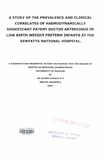| dc.contributor.author | Aduro, K N P | |
| dc.date.accessioned | 2014-02-03T06:31:37Z | |
| dc.date.available | 2014-02-03T06:31:37Z | |
| dc.date.issued | 2007 | |
| dc.identifier.citation | Aduro Kidaha N. P (2007). A Study Of The Prevalence And Clinical Correlates Of Haemodynamically Significant Patent Ductus Arteriosus In Low Birth Weight Preterm Infants At The Kenyatta National Hospital. Master Of Medicine (paediatrics) | en_US |
| dc.identifier.uri | http://hdl.handle.net/11295/64447 | |
| dc.description.abstract | Background: Haemodynamically significant patent ductus arteriosus
(hsPDA) is a common condition in preterm infants and is associated with
considerable morbidity and mortality. Although amenable to both
medical and surgical treatment, a limited number of patients are treated
at KNH because of under diagnosis in the absence of routine timed
echocardiography for preterm infants. At the KNH-NBU, preterm infants
who undergo echocardiographic evaluation for PDA are selected based
on presence of suggestive clinical signs. The prevalence of hsPDA at the
unit is therefore not known.
Objective: To determine the prevalence of haemodynamically
significant PDA and its clinical correlates among low birth weight
preterm infants.
Design: cross sectional descriptive study.
Setting: The newborn unit of the Kenyatta National Hospital
Methods: Over a three-month period 156 consecutive eligible low birth
weight preterm infants aged at least 3 days were recruited into the
study. A perinatal history was taken and physical examination done to
determine the presence of tachypnea, chest indrawing, and tachycardia,
bounding pulses, hyperactive precordium, murmur and hepatomegaly.
Echocardiographic evaluation was subsequently done to determine the
presence of hsPDA. A haemodynamically significant patent ductus
arteriosus (hsPDA) was considered present if a PDAwas associated with
a LA: AO ratio of > 1.5: 1. Those with hsPDA were compared to those
without hsPDAwith regard to clinical correlates.
Results: Eighty-one (51.9%) preterm infants had a PDA diagnosed by
echocardiography. Thirty of those infants with PDA had LA: AO ratio of
> 1.5: 1 giving a prevalence of hsPDA among low birth weight preterm
infants of 19.2%. The male to female ratio was 1.5: 1, mean birth
weight 1635 (1233-2047) g, mean gestational age 31.5 (29.3-33.7)
weeks and median postnatal age of 5 days (IQR 4-11). Of the 30 infants
with hsPDA, 10 (33.3%) had clinically diagnosed PDA. Clinical signs had
low positive predictive values with the most predictive signs being
hyperactive precordium 46.2%, murmur (systolic or continuous) 43.8%
and bounding peripheral pulses, 40.5%.
Conclusion: The echocadiographic prevalence of hsPDA was 19.2%
with only a third of these diagnosed clinically. Therefore, although
haemodynamically significant PDA is common in this unit, reliance on
clinical signs alone leads to underdiagnosis. Improved availability and
utilization of echocardiography in the unit will enhance the diagnosis
and management of patients with hsPDA. | en_US |
| dc.language.iso | en | en_US |
| dc.publisher | University of Nairobi | en_US |
| dc.title | A Study Of The Prevalence And Clinical Correlates Of Haemodynamically Significant Patent Ductus Arteriosus In Low Birth Weight Preterm Infants At The Kenyatta National Hospital | en_US |
| dc.type | Thesis | en_US |
| dc.description.department | a
Department of Psychiatry, University of Nairobi, ; bDepartment of Mental Health, School of Medicine,
Moi University, Eldoret, Kenya | |

